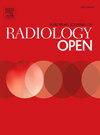双层光谱CT放射组学和深度学习鉴别成骨细胞骨转移和骨岛的诊断价值
IF 2.9
Q3 RADIOLOGY, NUCLEAR MEDICINE & MEDICAL IMAGING
引用次数: 0
摘要
本研究旨在比较双层光谱检测器计算机断层扫描(DLSCT)和应用于传统CT图像的深度学习(DL)模型的放射学特征在区分成骨细胞骨转移(OBM)和骨岛(BI)中的诊断性能。方法本回顾性研究纳入了2023年3月至2023年9月期间接受DLSCT检查的成骨病变患者。我们从常规图像和光谱图像中提取一阶放射特征(例如,平均值,最大值,熵)。将先前验证的DL模型应用于常规CT图像。我们使用ROC曲线分析评估诊断效果,比较AUC、敏感性和特异性。结果共纳入94例患者的216个病变(66例 ± ,12岁,男48例,女46例):BI 125个,OBM 91个。在一阶放射学特征的平均值、最大值、熵和均匀性方面,OBM组和BI组之间存在显著差异(P均为 <; 0.05)。DLSCT(来自VMI40keV的熵)和DL模型具有可比的auc (0.93 vs. 0.96; P = 0.274)。然而,与DL模型相比,DLSCT在诊断OBM方面表现出更高的灵敏度(92 %对62 %;P = 0.002)和相当的特异性(88 %对96 %;P = 0.07)。结论DLSCT的放射学特征可以区分BI和OBM,其诊断性能与DL模型相当。此外,与DL模型相比,VMI40keV图像衍生熵在诊断OBM方面表现出更高的灵敏度。本文章由计算机程序翻译,如有差异,请以英文原文为准。
Diagnostic performance of dual-layer spectral CT Radiomics and deep learning for differentiating osteoblastic bone metastases from bone islands
Background
This study aimed to compare the diagnostic performance of radiomic features derived from dual-layer spectral detector computed tomography (DLSCT) and a deep learning (DL) model applied to conventional CT images in the differentiation of osteoblastic bone metastases (OBM) from bone islands (BI).
Methods
This retrospective study included patients with osteogenic lesions who underwent DLSCT examinations between March 2023 and September 2023. We extracted first-order radiomic features (e.g., mean, maximum, entropy) from both conventional and spectral images. A previously validated DL model was applied to the conventional CT images. We evaluated diagnostic performance using ROC curve analysis, comparing AUC, sensitivity, and specificity.
Results
The study included 216 lesions from 94 patients (66 ± 12 years; 48 males, 46 females): 125 BI and 91 OBM lesions. Significant differences were observed between OBM and BI groups for the mean, maximum, entropy, and uniformity of first-order radiomic features (all P < 0.05). DLSCT (entropy from VMI40keV) and the DL model had comparable AUCs (0.93 vs. 0.96; P = 0.274). However, DLSCT showed superior sensitivity (92 % vs. 62 %; P = 0.002) but comparable specificity (88 % vs. 96 %; P = 0.07) for diagnosing OBM compared to the DL model.
Conclusion
Radiomic features from DLSCT differentiate between BI and OBM with diagnostic performance comparable to that of a DL model. Furthermore, VMI40keV image-derived entropy demonstrated superior sensitivity in diagnosing OBM compared to the DL model.
求助全文
通过发布文献求助,成功后即可免费获取论文全文。
去求助
来源期刊

European Journal of Radiology Open
Medicine-Radiology, Nuclear Medicine and Imaging
CiteScore
4.10
自引率
5.00%
发文量
55
审稿时长
51 days
 求助内容:
求助内容: 应助结果提醒方式:
应助结果提醒方式:


